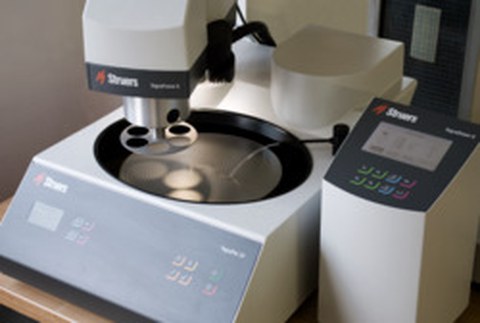surface pretreatment
Fields of application
The durability of adhesive bonding is decisively influenced by the surface finish of the joining parts. In particular, the wettability of the surfaces and the presence of energetically active centers are necessary preconditions for the formation of sufficiently high adhesive forces. In order to produce these properties on the substrate surfaces, various surface pretreatment methods can be applied after cleaning processes.
The surface pretreatment methods are applied to:
- cleaning and activation of joining surfaces,
- improvement of surface wettability,
- ensuring the reproducibility of adhesive compounds,
- Increasing the durability of the bonds.
Methods
The pyrosil process is a flame pyrolysis, with which a few nanometer-thin, amorphous, highly crosslinked silicate layer is produced on the substrate materials. The surface to be treated is guided through the oxidizing region of a gas flame, into which a silicon-containing substance, the "precursor", is metered. This results in a defined chemical structure on the substrate surface with important binding elements for the later adhesion of various materials. Thus, for example, the nanoporous structure of the silicate layer ensures better mechanical anchoring of the subsequently applied adhesive and the active centers which are introduced enable its more optimal chemical bonding.
The atmospheric plasma process is used for surface pretreatment of materials by means of an ionized gas jet. This plasma results in a cleaning as well as a chemical change and activation of the surface, which considerably improves the adhesion forces on numerous substrates. In addition to these processes, the atmospheric plasma offers the possibility to coat a wide range of materials with a suitable carrier substance. This allows the adhesion problems on these surfaces to be specifically countered. In order to adapt the process of the open air plasma to the respective materials, various parameters, such as the nozzle spacing, the speed and the offset, can be adjusted accordingly.
In the case of sand-jet coating, which is known under the name SACO process, the surface is treated, inter alia, with chemically modified blasting material. Cleaning components of the surface are removed and at the same time a surface coating takes place. Due to the impact energy of the blasting material, the high temperatures generated in the so-called triboplasma effect the incorporation of the reactive components of the blasting material into the surface. By means of this method, the adhesion behavior of the materials can be decisively improved, but the method is only conditionally suitable for materials such as glass or plastics, since the treatment involves a negative influence in the form of turbidity.
The TegraPol 35 grinding and polishing machine with TegraForce 5 sample mover and TegraDoser from Struers offers the possibility of targeted sample preparation. Both for the production of defined surface roughness as well as for the production of planar surfaces, this device is the best choice for the pretreatment of joints at the trial stage. With the help of various grinding and polishing programs and the use of suitable consumables, almost all materials can be processed. Optimally prepared surfaces are thus obtained for the plasmatreater or the microscopes. The TegraForce 5 attachment makes both single sample preparations and - via central pressure - multiple preparation possible. The dosing unit ensures reproducible grinding and polishing processes.
Dynamic Differential Calorimetry (DSC) is an analysis method for determining characteristic temperatures and calorific values such as the specific heat capacity. The measurement is based on the detection of the heat flow of the sample compared to a reference sample. The results allow conclusions about morphological parameters such as crystallinity or the detection of annealing and curing processes. In addition to the pure heat capacity, phase transitions as well as exo or endothermic reaction processes can be detected since the change in the process-induced thermal energy is detected by the heat flow measurement. The temperature-modulated DSC is a further development. The underlying linear heating rate is superimposed by a sinusoidal temperature modulation.





